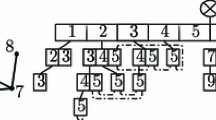Abstract
In this paper we compare the efficiency of several simplicial variable dimension algorithms. To do so, we first treat the issues of degeneracy and accelerating. We present a device for solving degeneracy. Furthermore we compare several accelerating techniques. The technique of iterated quasi-Newton steps after each major cycle of the simplicial algorithm is implemented in a computer code, which is used to compare the efficiency of the (n+1)-ray, 2n-ray, 2n-ray and (3n−1)-ray algorithms. Except for the (n+1)-ray algorithm, the number of function evaluations does not differ very much between the various algorithms. It appeared, however, that the 2n-algorithm needs considerably less computation time.
Similar content being viewed by others
References
E.L. Allgower and K. Georg, “Simplicial and continuation methods for approximating fixed points and solutions to systems of equations”,SIAM Review 22 (1980) 28–75.
M.N. Broadie, “Computational experience with the octahedral algorithm and related results”, Department of Operations Research, Stanford University (Stanford, California, 1983).
A.R. Colville, “A comparative study of nonlinear programming codes, Scientific Center Report 320-2949, IBM (New York, 1968).
J.E. Dennis and J.J. More, “Quasi-Newton Methods, motivation and theory”,SIAM Review 19 (1977), 46–89.
B.C. Eaves and R. Saigal, “Homotopies for computation of fixed points on unbounded regions”,Mathematical Programming 3 (1972) 225–237.
D.M. Himmelblau, “A uniform evaluation of constrained optimization techniques”, in: F. Lootsma, ed.,Numerical methods for nonlinear optimization (Academic Press, 1972).
R.B. Kellogg, T.Y. Li and Y. Yorke, “A constructive proof of the Brouwer fixed point theorem and computational results”,SIAM Journal of Numerical Analysis 13 (1976) 473–483.
M. Kojima and Y. Yamamoto, “Variable dimension algorithms: Basic theory, interpretations and extensions of some existing methods”,Mathematical Programming 24 (1982) 177–215.
M. Kojima and Y. Yamamoto, “A unified approach to several restart fixed point algorithms for their implementation and a new variable dimension algorithm”, Discussion Paper 151 (82-18), Institute for Socio-Economic Planning, University of Tsukuba (Sakura, Japan, April 1982, revised May 1983).
G. van der Laan and A.J.J. Talman, “A restart algorithm without an artificial level for computing fixed points on unbounded regions”, in: H.-O. Peitgen and H.-O. Walther, eds.,Functional differential equations and approximations of fixed points (Springer, Berlin, 1979) pp. 247–256.
G. van der Laan and A.J.J. Talman, “Convergence and properties of recent variable dimension algorithms”, in: W. Forster, ed.,Numerical solution of highly nonlinear problems (North-Holland, Amsterdam, 1980), pp. 3–36.
G. van der Laan and A.J.J. Talman, “An improvement of fixed point algorithms by using a good triangulation”,Mathematical Programming 18 (1980) 274–285.
G. van der Laan and A.J.J. Talman, “A class of simplicial restart fixed point algorithms without an extra dimension”,Mathematical Programming 20 (1981) 33–48.
O.H. Merrill, “Applications and extensions of an algorithm that computes fixed points of certain upper semi-continuous point to set mapping”, Ph.D. Thesis, University of Michigan (Ann Arbor, Michigan, 1972).
P.M. Reiser, “A modified integer labelling for complementarity algorithms”,Mathematics of Operations Research 6 (1981) 129–139.
R. Saigal, “On the convergence rate of algorithms for solving equations that are based on complementarity pivoting”,Mathematics of Operations Research 2 (1977) 108–124.
R. Saigal, “A homotopy for solving large, sparse and structured fixed point problems”,Mathematics of Operations Research 8 (1983) 557–578.
R. Saigal, “Computational complexity of a piecewise linear homotopy algorithm”,Mathematical Programming 28 (1984) 164–173.
R. Saigal and M.J. Todd, “Efficient acceleration techniques for fixed point algorithms”,SIAM Journal of Numerical Analysis 15 (1978) 997–1007.
A.J.J. Talman, “Variable dimension fixed point algorithms and triangulations”, Mathematical Centre Tract 128 (Mathematisch Centrum, Amsterdam, 1980).
M.J. Todd, “Improving the convergence of fixed point algorithms”,Mathematical Programming Study 7 (1978) 151–169.
M.J. Todd, “Global and local convergence and monotonicity results for a recent variable-dimension simplicial algorithm”, in: W. Forster, ed.,Numerical solution of highly nonlinear problems (North-Holland, Amsterdam, 1980), pp. 43–69.
M.J. Todd, “An introduction to piecewise-linear homotopy algorithms for solving systems of equations”, in: A. Dold and B. Eckman, eds.,Topics in Numerical Analysis (Springer, Berlin, 1982), pp. 149–202.
M.J. Todd, Approximate labelling for simplicial algorithms and two classes of special subsets of the sphere”,Mathematics of Operations Research 6 (1981) 579–592.
A.H. Wright, “The octahedral algorithm, a new simplicial fixed point algorithm”,Mathematical Programming 21 (1981) 47–69.
Y. Yamamoto, “A new variable dimension algorithm for the fixed point problems”,Mathematical Programming 25 (1983) 329–342.
Author information
Authors and Affiliations
Rights and permissions
About this article
Cite this article
van der Laan, G., Seelen, L.P. Efficiency and implementation of simplicial zero point algorithms. Mathematical Programming 30, 196–217 (1984). https://doi.org/10.1007/BF02591885
Received:
Revised:
Issue Date:
DOI: https://doi.org/10.1007/BF02591885




